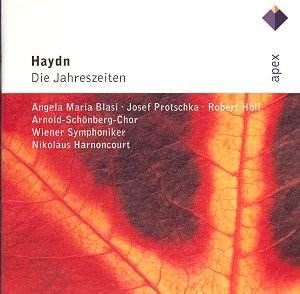Of the two oratorios
Haydn wrote in his old age The Creation is the more dramatic
and immediate while The Seasons is more idyllic. It’s
also a good deal longer, which to some extent explains why The
Creation is regularly performed while its country cousin
is a comparatively rare visitor to the concert hall. There is
no denying that the later work contains a lot of good music
and has a more folksy character; Austrian folk music is never
far away. It is also has a more leisurely pace with long stretches
of admittedly beautiful but slow and restrained music. There
are moments of drama also, for example the end of part II, Summer
(CD1 tracks 16 – 18), where in the recitative the soloists build
up the tension. This describes how the air changes, the sky
turns black, “the muted roar from the valley that announces
the furious tempest”. We hear the timpani murmuring in the distance
and suddenly lightning flashes, the thunder rolls and the people
(the chorus) are dismayed and frightened. Harnoncourt makes
the most of this, rhythmically alert and backed up by the excellent
Arnold Schönberg-Choir. Suddenly the thunderstorm is over, the
sun looks out again and the soloists and the choir rejoice.
Part III, Autumn,
is actually the season when things happen. Farmers delight in
the rich harvest in the fugal choral setting at the end of the
trio (CD2 track 2). The hunting chorus with its braying horns
is another peak (CD2 track 8). Autumn ends with a lively drinking
chorus (CD2 track 10) and a dancing finale. All of this is finely
done with precision and high spirits.
As is his wont Harnoncourt
works with contrasts. Sometimes these can sound over-done, as
in some of his Mozart operas, but here his approach pays dividends
and keeps the listener’s interest alive. His tempos are generally
well judged. Making random comparison with another great Haydn
conductor, Antal Dorati, often reveals similar speeds, give
or take a few seconds in individual numbers. The Vienna Symphony
Orchestra play well – this is no period instrument performance
– and the choir, trained by Erwin Ortner, is one of Europe’s
best.
Dorati, recorded
roughly ten years before Harnoncourt, has the RPO and the Brighton
Festival Chorus, and generally there is little to choose between
these two versions. Even further back, in the late 1960s, DG
recorded the work, also with the Vienna Symphony but this time
paired with the Vienna Singverein and with Karl Böhm conducting.
This has always been regarded as a top contender and I have
enjoyed it since its first release. Böhm may be more old-fashioned
but he was always a sure-footed interpreter of the Vienna classics.
Each of these three versions is valid and enjoyable in its own
terms.
Maybe the deciding
factor will be the soloists – and they are important in this
work. They have a lot to sing, in recitatives and arias and
in ensembles, mostly trios. Böhm has a magnificent trio of singers:
Peter Schreier and Martti Talvela, both of them just turned
thirty, and Gundula Janowitz was even younger. Talvela owned
one of the most gigantic bass voices ever heard and sings with
great authority and feeling while Schreier at this early stage
of his career possessed a rounded sappy voice with a lot of
character. The young Janowitz is in her creamiest voice. But
Dorati’s trio is not far behind: the lovely Ileana Cotrubas,
the lyrically shining Werner Krenn and the impressive Hans Sotin.
How do Harnoncourt’s
singers measure up against these predecessors? On the whole
very well indeed. Josef Protschka is a fine lyrical tenor with
a certain similarity to Schreier. He can sing ravishing pianissimos
as in his cavatina Dem Druck erlieget die Natur (CD1
track 13) but he has also ringing power for the Winter-aria
Hier steht der Wandrer nun (CD2 track 14). The soprano
Angela Maria Blasi has a lovely lyrical voice, bright and light,
singing very sensitively and with a good trill in her Summer-aria
(CD1 tracks 14-15). Robert Holl has a strong darkish voice,
prone to be a bit ungainly and adopting a slight beat when under
pressure. He is however a sensitive artist, a renowned Lieder-singer,
and can tone things down to a ravishing half-voice. He is at
his very best in the largo near the end of Winter, Erblicke
hier, betörter Mensch. There his voice rings out with greater
freedom than in any of the earlier parts.
As a reviewer I
am supposed to be able to give a clear recommendation – but
I can’t. Let me put it this way: I have always been fond of
the Böhm version, having lived with it for nearly forty years;
when I got the Dorati I admired his lighter touch. Harnoncourt,
more filled with contrasts than either of the others, is perhaps
the version for the new millenium. You can’t go far wrong, whichever
you choose and Harnoncourt, recorded live in good sound and
very few extraneous noises, is on two well-filled budget-priced
discs with a good essay in the booklet. And, lo and behold,
full texts and translations!
Göran Forsling

![]() Angela Maria
Blasi (soprano) – Hanne
Angela Maria
Blasi (soprano) – Hanne![]() WARNER APEX 2564 62086-2
[73:51 + 71:14]
WARNER APEX 2564 62086-2
[73:51 + 71:14]





